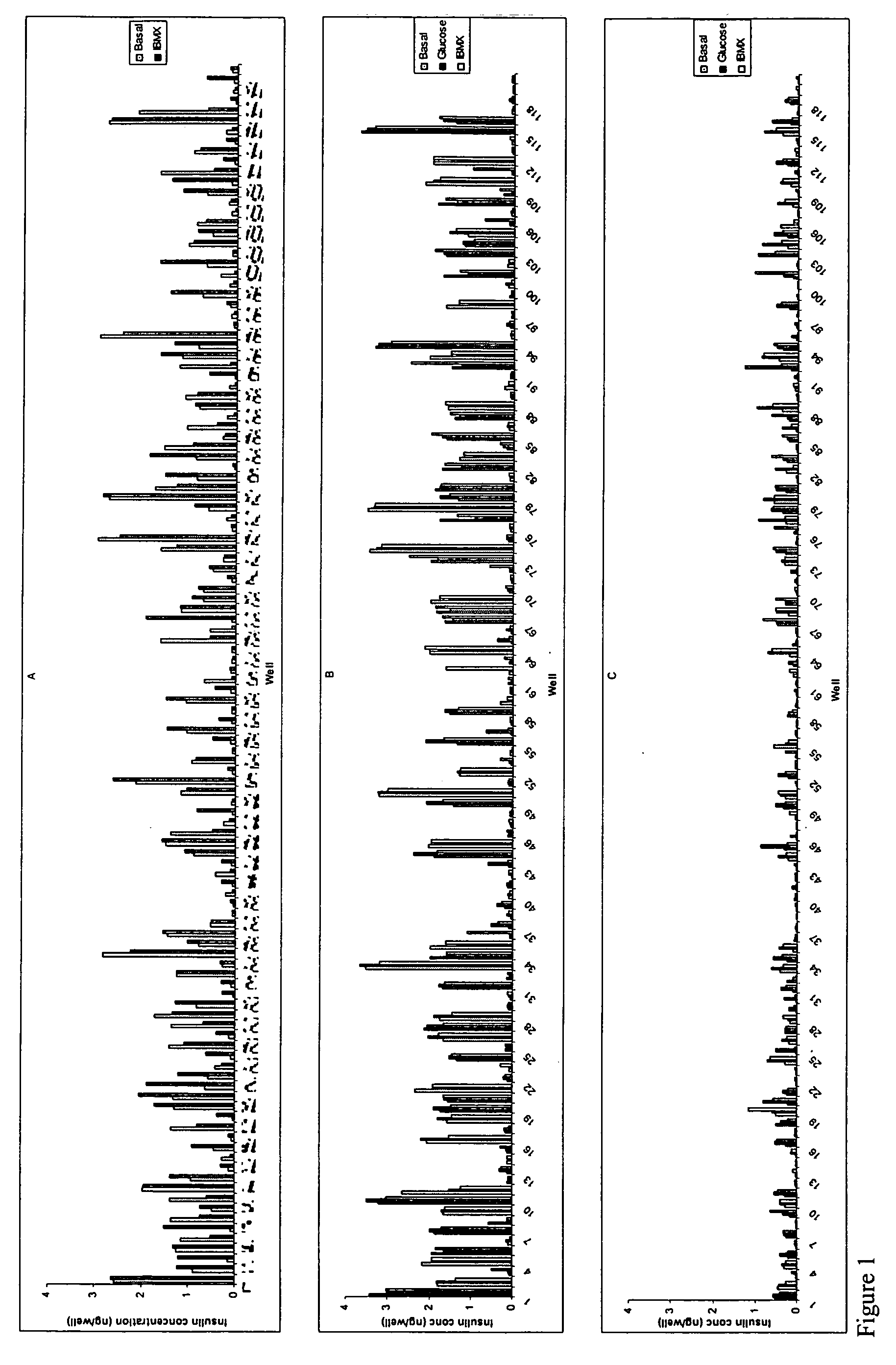Methods, compositions, and growth and differentiation factors for insulin-producing cells
a technology of growth and differentiation factors and compositions, applied in the direction of drug compositions, artificial cell constructs, metabolic disorders, etc., can solve the problems of wasting the appearance of many patients with poorly controlled insulin-dependent diabetes, extreme hypoglycemia and coma followed by death, and inability to reach the intracellular places where glucose is needed and utilized
- Summary
- Abstract
- Description
- Claims
- Application Information
AI Technical Summary
Problems solved by technology
Method used
Image
Examples
example 1
[0267] Sequential Culture of Pancreatic Cells in Alginate Followed by Suspension Culture
[0268] Pancreatic cells were cultured for 6-12 days in 1.6% alginate in a medium consisting of a mixture of DMEM and Ham's F12 nutrient mixture supplemented with 10% FBS, insulin, transferrin, selenium and EGF resulting in the generation of stem cells. Stem cells were harvested from the alginate beads by depolymerization and cultured in suspension in ultra low adherence plates (Costar) for 11 days in basal medium supplemented with combinations of 60 growth and differentiation factors in a 120 combinatorial array. At the end of the culture period cells were subjected to a 24 hr challenge with basal glucose medium (5 mM glucose), 20 mM glucose or 20 mM glucose+IBMX. Supernatants were harvested and analyzed for insulin content using an ELISA. Cells were washed and lysed and the DNA content per well determined using a picogreen assay The "insulin difference" was calculated by the subtraction of the i...
example 2
[0270] Sequential culture of stem cells in alginate followed by adherent culture.
[0271] Pancreatic cells were cultured for 6-12 days in 1.6% alginate in a medium consisting of a mixture of DMEM and Ham's F12 nutrient mixture supplemented with 10% FBS, insulin, transferrin, selenium and EGF resulting in the generation of stem cells. Stem cells were harvested from the alginate beads by depolymerization, and cultured in adherent culture, on collagen coated plates for 8 days in basal medium supplemented with combinations of 60 growth factors in a 120 combinatorial array. At the end of the culture period cells were subjected to a 24 hr challenge with basal glucose medium (5 mM glucose), 20 mM glucose or 20 mM glucose+1 mM IBMX. Supernatants were harvested and analyzed for insulin content using an ELISA. Cells were washed and lysed and the DNA content per well determined using a picogreen assay. The "insulin difference" was calculated by the subtraction of the insulin content in wells sti...
example 3
[0273] Culture of Stem Cells in Alginate Culture.
[0274] Pancreatic cells were cultured for 6-12 days in 1.6% alginate in a medium consisting of a mixture of DMEM and Ham's F12 nutrient mixture supplemented with 10% FBS, insulin, transferrin, selenium and EGF resulting in the generation of stem cells. Stem cells were harvested from the alginate beads by depolymerization, and recast into 1.2% alginate beads and cultured for an additional 7-11 days in basal medium supplemented with combinations of 60 growth factors in a 120 combinatorial array. At the end of the culture period cells were subjected to a 24 hr challenge with basal glucose medium (5 mM glucose), 20 mM glucose or 20 mM glucose+1 mM IBMX. Supernatants were harvested and analyzed for insulin and C-peptide content using an ELISA. Alginate beads were depolymerized and the cells were washed and lysed and the DNA content per well determined using a picogreen assay
[0275] Insulin and c-peptide data from 4 replicate experiments usi...
PUM
| Property | Measurement | Unit |
|---|---|---|
| molecular weight | aaaaa | aaaaa |
| concentration | aaaaa | aaaaa |
| concentration | aaaaa | aaaaa |
Abstract
Description
Claims
Application Information
 Login to View More
Login to View More - R&D
- Intellectual Property
- Life Sciences
- Materials
- Tech Scout
- Unparalleled Data Quality
- Higher Quality Content
- 60% Fewer Hallucinations
Browse by: Latest US Patents, China's latest patents, Technical Efficacy Thesaurus, Application Domain, Technology Topic, Popular Technical Reports.
© 2025 PatSnap. All rights reserved.Legal|Privacy policy|Modern Slavery Act Transparency Statement|Sitemap|About US| Contact US: help@patsnap.com



